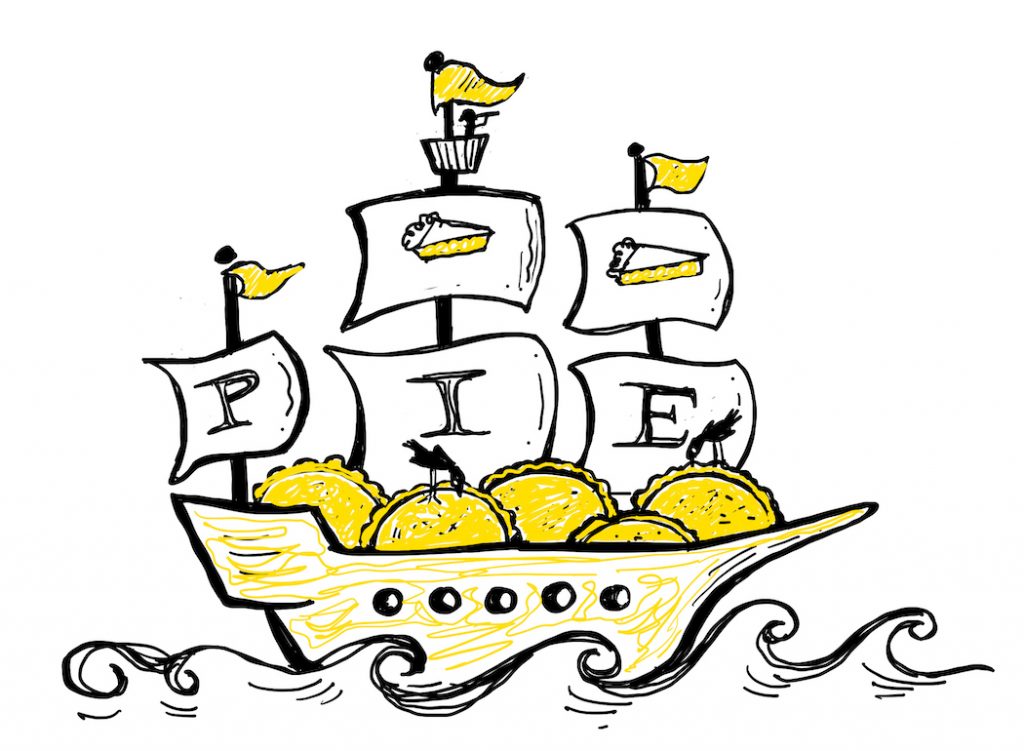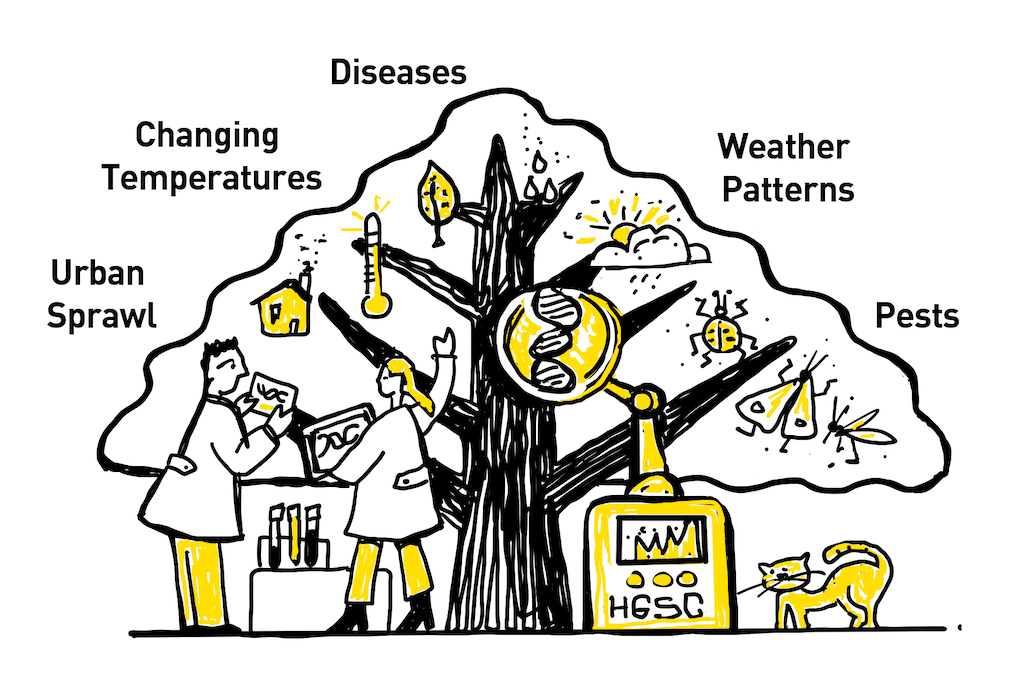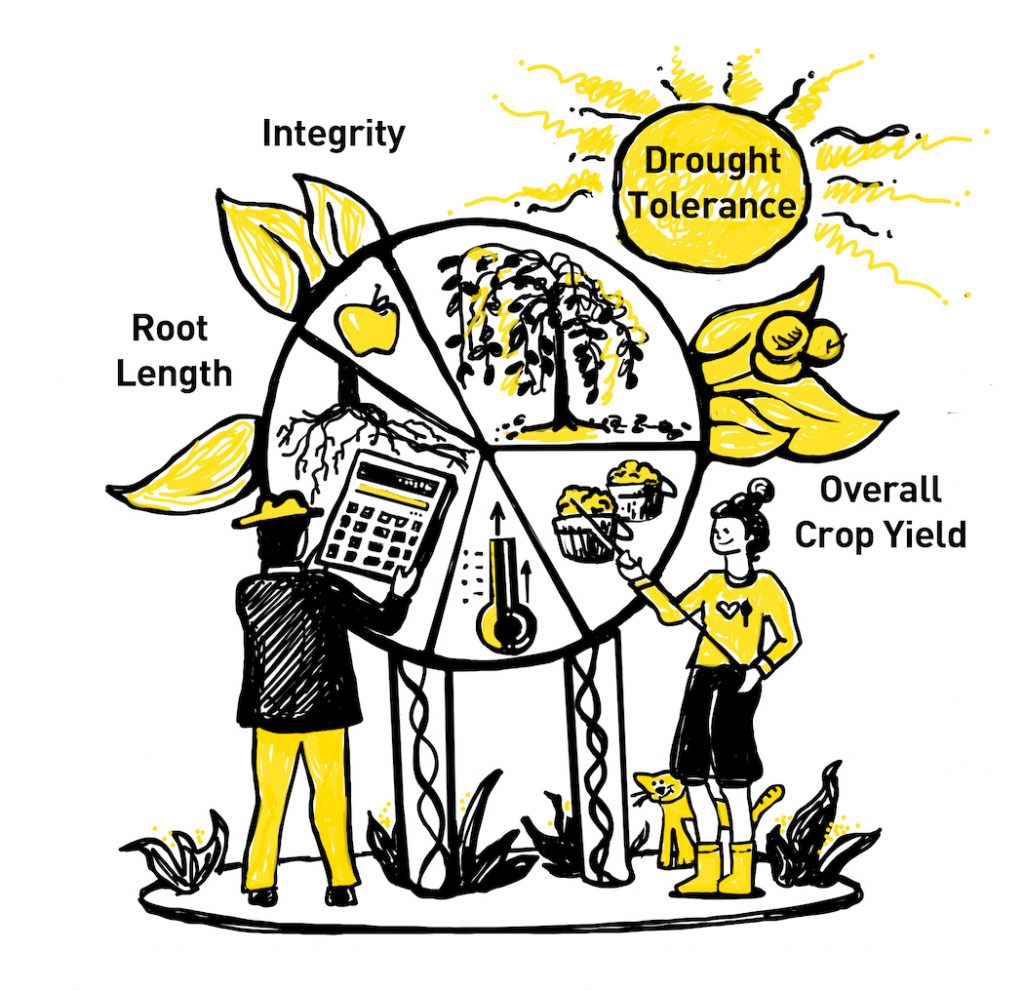An Everyday DNA blog article
By: Sarah Sharman, PhD
Illustrated by: Cathleen Shaw
For my family, Thanksgiving means gathering together, cooking traditional family recipes, and eating too much food. Turkey and dressing, green bean casserole, and mashed potatoes abound, but for me, it’s what comes after Thanksgiving dinner that is the star of the show. I love pie – apple, pumpkin, cherry, chocolate, they’re all so delicious.
Although all of these pies taste different, they are each made using ingredients derived from plants that are facing challenges amidst our changing climate. Genetics is a powerful tool for ensuring that we do not run out of the basic ingredients to make sure there is always pie at the table for Thanksgiving. Let’s learn more about the history of pie and how genetics plays a role in preserving some of the most important ingredients of our favorite Thanksgiving desserts.
A brief history of pie
The term ‘pie’ covers a broad dichotomy of sweet and savory pastries. Pies are not a new culinary trend. Their origin dates back to ancient civilizations. As early as 2500 BC, Egyptians made pies containing a mix of meats, vegetables, and fruits encased in a simple dough made from barley and oats.
Pies offered a practical solution for storing all kinds of perishable ingredients in pre-refrigeration days. Meat, game, fish, fruits, vegetables, grains, spices, and more familiar fillings like berries, nuts, and custards, were mixed and matched in thick pie crusts. The contents could be preserved for months if fat was poured into a hole in the crust’s lid after baking. From another pragmatic standpoint, small, folded-over hand pies were easy to take on the go, giving travelers and field laborers a hearty meal to stash safely in their pockets or rucksacks until mealtime.
Pies came to the newly formed United States with the first English settlers who brought their longstanding tradition of meat and fruit-filled pastry pies. Ingredients locally available in America, such as pumpkins and apples, led to the creation of quintessential American pies like pumpkin and apple pie. These pies became cherished dishes in the early American culinary landscape, and their popularity endured through the centuries.
It wasn’t until the 19th century that pies became a staple Thanksgiving dessert. At this time, Sarah Joseph Hale, an American reformer, author, and editor, advocated tirelessly for Thanksgiving to become a national holiday. She wrote about Thanksgiving traditions in her book Northwood: Life North and South, including an entire chapter revolving around pumpkin pie. In the early to mid-1900s, the mass production of pre-made pie crusts and canned pumpkin filling further propelled Thanksgiving pies into the spotlight.


It all starts with the crust
By definition, you can’t have pie without a crust. The crust not only provides a vessel for the tasty filling, but it also adds buttery flavor and crunchy texture. The flour that is so critical to a pie crust is typically made from wheat or other cereal grains. Extreme heat, changing rainfall patterns, and other extreme weather events will make growing staple crops like wheat harder in the coming years. While cereal grains are important for making a tasty pie crust, they are even more crucial in serving as a primary source of calories to most of the world’s population. The loss of cereal grains to climate change would be globally detrimental.
Many scientists and crop breeders across the globe are turning to genetics to try to save cereal crops threatened by our changing climate. Looking within the genome of these crops, scientists can identify parts of the genome that contribute to beneficial traits like drought tolerance, root length and integrity, and overall crop yield.
Experts at the HudsonAlpha Genome Sequencing Center (GSC) are integral in many projects focused on understanding and improving cereal grains and cereal grain alternatives. They’ve sequenced and analyzed the genomes of several species of grains like sorghum, finger millet, foxtail millet, rice, maize, perennial wheatgrass, and barley. The genomes are an important tool for breeding cereal grains that are better adapted to our changing climate.
The star of the show: the filling
Pie filling is the subject of many a family debate around my house. I love the sweet and spicy aroma of a freshly baked pumpkin pie. My uncle is partial to raisin pie, while my sister loves a traditional apple pie. We usually compromise and end up with a Thanksgiving dessert table consisting of a traditional pumpkin, apple, or pecan pie and maybe a chocolate or peanut butter pie for the non-traditionalists in the family.
Like the cereal crops we discussed earlier, the plants that produce ingredients like apples, pecans, and peanuts are in danger of poor or reduced productivity in response to changing climates and increased pests and diseases. Scientists at HudsonAlpha Institute for Biotechnology rely on the power of genomics to help improve plants and ensure farmers, producers, and consumers have access to quality, healthy, and nutritious food.
Pecan
Pecan trees are native to North America, primarily in the southeastern and central regions of the U.S. They offer a range of health benefits through their healthy fats and antioxidants, satiating fiber, and vitamin E content. Pecans were an important food source for indigenous people for centuries before the arrival of early American colonists, who also adopted them as a staple of their diets.
In the late 19th and early 20th centuries, Americans began attempting to cultivate pecan trees for their nuts. Growers, predominantly in the southern states, started selecting and breeding pecan varieties to improve nut quality and consistency. The development of disease-resistant and high-yield pecan varieties further boosted production. Today, pecans are a significant commercial crop in the U.S. which is one of the world’s leading pecan producers.
Despite the success of pecan cultivation and production in the US, there are still many factors that threaten successful pecan harvests. Changing temperatures and weather patterns, urban sprawl, and emerging diseases and pests can all threaten the integrity of pecan harvests. Scientists at the HudsonAlpha GSC, led by John Lovell, PhD, are interested in using genomics to understand various nut traits like size, allergen content, flavor, and nutrition. They’ve sequenced the genomes of four different pecan varieties to begin identifying regions of the genome that contribute to various traits. 
The team is also interested in growing pecan in new environments. They built a genome for a type of pecan from the very southern edge of its natural growing range and are in the process of generating genomes for one from the far north. Comparing the genomes will give the GSC team candidate genes that allow pecans to grow in stressful environments, which could be helpful when trees are moved to new orchard locations or responding to climate change.
Apple
 Apple pie is a staple at many Thanksgiving tables, thanks to the apple harvest season aligning with late fall. The U.S., especially Washington, New York, and Michigan, is a leading producer of apples worldwide, despite being home to no native apples besides crabapple. All of the apples we grow in the States were either brought to America from other countries or were bred here from the international apple trees.
Apple pie is a staple at many Thanksgiving tables, thanks to the apple harvest season aligning with late fall. The U.S., especially Washington, New York, and Michigan, is a leading producer of apples worldwide, despite being home to no native apples besides crabapple. All of the apples we grow in the States were either brought to America from other countries or were bred here from the international apple trees.
Venturing to apple orchards to pick apples straight from the tree is a fun fall activity for many Americans. For the hobby apple picker, the perfect apple is usually colorful and within reach of the ground. The experience is often more important than the product, so if the apple was too ripe, nothing was ultimately lost.
However, for commercial apple growers, picking apples at the right time is critical for ensuring that apples meet consumer expectations, have a longer shelf life, and remain competitively viable in the marketplace. Currently, growers measure apple flesh firmness and starch content to determine if apples are of the appropriate ripeness. When apples start to ripen, they convert starch to sugar, making the apple taste sweet and perfect. As apples ripen, they also become softer. The firmness and starch tests help predict how long apples can be stored successfully in controlled atmosphere storage. These tests work okay, but there are so many types of apples that all develop a little bit differently that it is not foolproof.
A lot of apple varieties share similar genetics. HudsonAlpha Faculty Investigator Alex Harkess, PhD, and his lab believe they could lean on genetics to help growers better time apple harvests for less crop loss due to food spoilage. The team is collaborating with Loren Honaas’ laboratory at the USDA and other colleagues at Washington State University and the Washington Tree Fruit Research Commission to find a signature in an apple detectable with a genome sequencer that allows growers to perfectly time when to pick an apple off a tree.
The team will sequence the genes of apples during their entire development. They hope to pinpoint the genes that are turning on and off during development to isolate a set of these genes that are predictive of maturity. A genetic test would be better than the traditional firmness and starch tests because it would directly correlate with the biological processes occurring in a developing apple.





